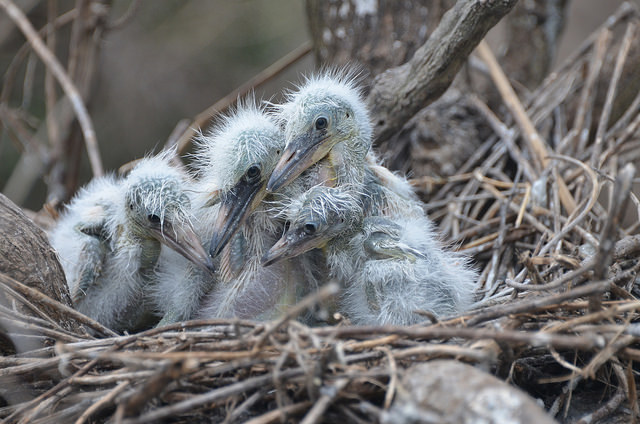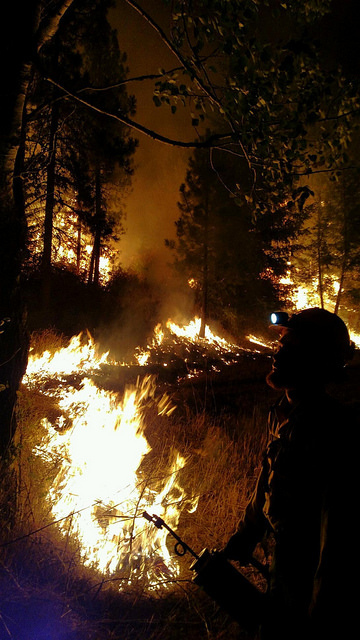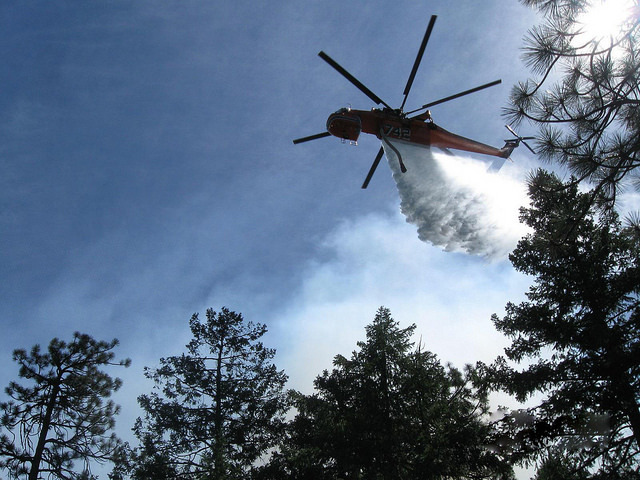Having trouble viewing this email? View it as a Web page.

Preserving and Restoring Our Water, Soil and Lands
ICYMI, here's what happened last week at USDA:
The heart of USDA’s mission is to put in place sound policies that lay a steady groundwork for a better future for our children and our children’s children. That means using the resources we have today to invest in creative solutions to tomorrow’s challenges.
USDA's management of our national lands and our support for farmers’ and ranchers’ stewardship of private working lands not only helps to support a robust and thriving rural economy, but also meets our moral obligation to the next generation to leave our land, water, and wildlife better than we found it. Our efforts to strengthen rural economies by providing farmers and ranchers the resources they need to feed their families and our nation can at the same time promote clean air, clean water, and thriving wildlife habitat on both public and private land. No one knows the importance of conservation more than our nation’s farmers and ranchers. And we are here to support them.
With record fires currently burning out West, the importance of forest management is front and center in our nation’s policy discussion. Unprecedented resources are being spent to combat fires throughout the U.S., which means the Forest Service’s budget for non-fire operations, including forest conservation and management activities that lessen the threat of wildfires, are at risk. The work we do today to create and maintain resilient forests will have lasting impacts on our future generations.
Throughout the month, we’ll focus on our partnerships and collaborative efforts that will ensure our national forests and private working lands are conserved, restored, and made more resilient to climate change. Follow along or join the conversation using hashtag #conservation.
The Week in Pictures
Hundreds of chicks are born each spring on an island rookery built from dredged materials.
All images available in Flickr.
On the USDA Blog
USDA: Leading the Way Towards Preserving and Restoring Our Water, Soil and Lands
Conservation of our nation’s natural resources is at the heart of USDA’s mission. Our work on public and private lands supports clean air, clean water, and thriving wildlife habitat. These conservation efforts strengthen rural economies by providing farmers and ranchers the resources they need to thrive and feed our nation. And this conservation allows us to support gateway communities and a robust recreation economy.
Forest Employees Partner to Provide Improved Access to Historic Cemetery
Since the 1800s, heirs of the San Joaquin del Rio de Chama Land Grant in northern New Mexico have been tending to graves and religious sites in a small cemetery at the top of a mesa in the Chama River Canyon. For at least three decades, they had to travel by foot up the hill to reach the cemetery, which was assumed to lie within the boundaries of the Chama River Canyon Wilderness Area.
Reducing Food Waste is Child’s Play
The famous Julia Child once said “people who love to eat are always the best people,” but what would Julia say about eaters who waste food? In the United States, consumers discard about 20 percent of all food purchased. That adds up to approximately 90 billion pounds of food each year, costing each person $370 annually. For a family of four, that’s nearly $1,500.
Using Gypsum to Help Reduce Phosphorus Runoff
When it rains it pours. Whether we get a passing shower or a day-long downpour, the runoff ends up in rivers, streams and waterways. That runoff may include nutrients from fertilizers, and one of those nutrients is phosphorus. Phosphorus runoff is causing blooms of harmful algae that deplete waterways of oxygen, resulting in “dead zones” that damage ecosystems vital for aquatic life.
Working Together to Restore the Colorado Front Range
It started with a call from a concerned landowner living on Pine Country Lane, nestled in the foothills just west of Denver. The landscape spread out before them was scarred from previous high-severity fires, the homeowners told their local Conservation District. Their home was sitting at the top of a hill in a tinderbox surrounded by dense forests dying from bark beetle and tussock moth invasions.
Mixed Crop-Livestock Systems: Changing the Landscape of Organic Farming in the Palouse Region
Grazing livestock may soon be a common sight in the Palouse region of southeastern Washington, usually known for its rolling hills and grain production. Jonathan Wachter, a soil science doctoral student at Washington State University, has been working with a local farm to improve the competitiveness of organic mixed crop-livestock systems and their potential adoption by growers in a conventional grain-producing region.
Apalachicola National Forest Restores National Historic Landmark
The drive to Fort Gadsden’s Historic Site on the Apalachicola National Forest is something reminiscent of a nature documentary. Towering pines line the highway while vibrant wildflowers bloom throughout the fields. Local volunteers and Apalachicola National Forest employees are busily working in the stifling heat on a restoration project at this National Historic Landmark, the only one located in the southeast on National Forest Service land.
Read about us in the News
The Forest Service Spent $243 Million Fighting Wildfires In Just One Week (Buzzfeed)
The agency spent nearly a quarter billion dollars on fires last week, officials reported. The costs are so high that the agency has already used up this year’s entire firefighting budget. According to Agriculture Secretary Tom Vilsack, last week’s national firefighting costs totaled a record $243 million, the Associated Press reported. Vilsack also warned that the Forest Service will probably keep spending about $200 million a week fighting fires as the season drags on.
The Western sagebrush is a backdrop in every epic cowboy movie. Can it be saved? (Washington Post)
In less than two weeks, the Bureau of Land Management, which owns more than half of the land covered by sagebrush, along with the U.S. Forest Service, are expected to finalize a plan that will change how it has allowed mining operations, cattle ranchers and developers to lease big tracts and work the territory for decades…“If you can protect the species through incentives, why not try that, as opposed to a tool that will create concern and difficulty and resistance,” said Agriculture Secretary Tom Vilsack, whose agency works closely with ranchers.
Fight To Save The Sage Grouse Finds Friends In All Corners Of The West (NPR)
The greater sage grouse is a peculiar and distinctly Western bird. It's about the size of a chicken and about as adaptable as the dodo bird, which is to say it's not very adaptable at all — at least not in a human-driven time scale.… Just last week, the U.S. Department of Agriculture promised more than $200 million for sage grouse conservation efforts over the next three years, with the hopes of almost doubling the current amount of protected habitat. That's on top of about $400 million that they have already spent since 2010.
Forest Service Spends a Record $243M Last Week on Wildfires (Associated Press)
The U.S. Forest Service spent a record $243 million last week battling forest fires around the country, Agriculture Secretary Tom Vilsack said Thursday. The agency has spent all the money Congress provided for fighting wildfires in the 12-month budget period, forcing it to borrow money from forest restoration work designed to reduce the risk of fires. That's happened in six of the past 10 years, Vilsack said. Vilsack said further transfers are likely and the agency expects to continue spending about $200 million per week on fire suppression during the coming weeks.
As wildfires rage and budgets dwindle, more federal funds sought for firefighting (Los Angeles Times)
In a letter to regional foresters and other employees, Tom Tidwell, the chief of the Forest Service, said the agency would have to borrow money from other programs the agency runs, a practice that has become increasingly common as wildfires grow in size and intensity and increasingly threaten populated areas. This year, for the first time, the agency is spending more than half its budget to fight wildfires. “Once again we have to shut down many parts of our mission to fulfill our wildfire suppression responsibilities within the funds available to the agency,” Tidwell wrote last week.
U.S. agriculture chief talks wildfires in scorched West (Reuters)
U.S. Agriculture Secretary Tom Vilsack said on Friday the federal government has spent more than $1 billion fighting this year's deadly wildfires, which have scorched drought-stricken Western states. Vilsack told a news conference in Portland, Oregon, he supported a bill that would designate the very biggest blazes each year as national disasters. The U.S. Agriculture Department, which oversees the Forest Service, is spending more than $150 million a week beating back several dozen blazes, he said. Vilsack was joined by U.S. Senator Ron Wyden, an Oregon Democrat who is co-sponsor of a bipartisan bill that would assign national disaster status to the largest 1 to 2 percent of wildfires, freeing up emergency funding and preventing borrowing from fire prevention budgets.
Wildfires have now burned a massive 8 million acres across the U.S. this year (Washington Post)
As of Monday, according to the National Interagency Fire Center, more than 8 million acres have burned in U.S. wildfires in 2015. 8,122,876 of them, to be precise. That’s an area larger than the state of Maryland. And the numbers are still growing: 66 large fires are currently raging across the country, particularly in California, Oregon, Washington, Idaho and Montana. That includes two Washington state fire complexes that are larger than 100,000 acres burned. As of this writing, the United States remains at wildfire preparedness level 5 — the highest level — where it has been since Aug. 13…But it won’t take a record in order to ensure that 2015’s fire season has a major impact — on lives, homes, and also government budgets.
National Forests on the brink (Agri-Pulse)
It's another hot, dry summer, and another several million acres of public forests are going up in flames. As the end of August approaches, over 7 million acres have burned - including almost a million acres of National Forests, and those losses should concern all Americans… The Forest Service and other Federal and State firefighting agencies are making heroic efforts to combat these blazes, and so far at least four wild-land firefighters have given their lives in defense of life, property, and precious natural resources. Their valiant efforts have done a lot to reduce the damage, but it's an uphill fight…
Ranchers applaud $211 million boost to sage grouse protection (Capital Press)
That’s the story U.S. Agriculture Secretary Tom Vilsack and the USDA’s Natural Resources Conservation Service want to get across: Voluntary, collaborative efforts to improve sage grouse habitat are working. At a media briefing Aug. 27 in Portland, Vilsack announced the USDA will provide $211 million more in farm bill funding for Sage Grouse Initiative programs through 2018. The new round of funding, called SGI 2.0, includes $100 million for conservation easements, in which landowners are paid not to till sage grouse habitat but can still graze livestock.
New sage grouse strategy unveiled: $760 million invested by 2018 (High Plains Journal)
The Sage Grouse Initiative has enrolled 1,129 ranchers to conserve 4.4 million acres. Those numbers are hoped to double by 2018. Recently, the U.S. Department of Agriculture Secretary Tom Vilsack announced a renewed commitment to voluntary, incentive-based conservation efforts to bring back sage grouse populations. Vilsack unveiled the Sage Grouse Initiative 2.0 Investment Strategy, which includes an additional $211 million in farm bill funding for proactive and cooperative conservation efforts in the West.
New Money For Sage Grouse Conservation Announced (Utah Public Radio) [AUDIO]
U.S. Secretary of Agriculture Tom Vilsack announced a program on Thursday called Sage Grouse Initiative 2.0, in which he allocated $211 million for conservation efforts throughout the West. The initiative provides ranchers with resources to make conservation efforts on their own private land economically viable. The initiative is expected to conserve 8 million acres of land by 2018. Terry Messmer, the director of the community-based conservation program, has been involved with Sage-Grouse conservation for over 20 years.
Listen
DROUGHT NUMBERS CREEPING UPWARD
Broadcast Date: Thu, September 3, 2015
This past month has enlarged the area of the U.S. experiencing drought. (Gary Crawford and Brad Rippey)
ACTUALITY: NO DROUGHT PROBLEMS FOR MAJOR CORN AND SOYBEAN AREAS
Broadcast Date: Thu, September 3, 2015
Brad Rippey, USDA meteorologist, saying that the major corn and soybean areas have been mostly untouched by drought.
WILDFIRE ACREAGE APPROACHING RECORD TOTALS
Broadcast Date: Thu, September 3, 2015
The number of acres burned this year by wildfires is approaching a record high. (Gary Crawford and Brad Rippey)
CRP CONTRACT EXTENSION OFFERING
Broadcast Date: Wed, September 2, 2015
Those landowners with Conservation Reserve Program contracts expiring on September 30 have an extension offer available. (Rod Bain and Farm Service Agency Administrator Val Dolcini)
SOURCES TO HELP YOU CHOOSE HIGH EFFICIENCY FARM LIGHTING SYSTEMS
Broadcast Date: Wed, September 2, 2015
Ag producers have many ways to determine cost savings and fit for a new high efficiency lighting system for their farm or ranch. (Rod Bain and Daniel Ciolkosz (Pronounced "Cho-kus") of Penn State University Extension
BOTTOM LINE OF HIGH EFFICIENCY LIGHTING SYSTEMS ON THE FARM
Broadcast Date: Wed, September 2, 2015
There are some ways farmers can budget for a high efficiency lighting upgrade on their farms, and get their money's worth from such a system. (Rod Bain and Daniel Ciolkosz (Pronounced "Cho-kus") of Penn State University Extension
PASTURES HAVEN'T LOOKED THIS GOOD IN A LONG TIME
Broadcast Date: Tue, September 1, 2015
As we start September, the nation's pastures and rangelands are in the best September shape they've been in for a long time. (Gary Crawford, Shayle Shagam and Brad Rippey)
NEW FALL WEATHER PATTERN WILL HELP WESTERN FIREFIGHTERS
Broadcast Date: Tue, September 1, 2015
Firefighters in the Northwest will be getting a major break with better weather this week. (Gary Crawford and Brad Rippey)
Share
USDA: Leading the way towards preserving & restoring our water, soil & lands http://t.co/r7gsUZMbsJ #conservation pic.twitter.com/kCSo7QVmi4
— Dept. of Agriculture (@USDA) September 4, 2015
Using gypsum to help reduce phosphorus runoff http://t.co/5BMDMMG3yG pic.twitter.com/YMJ25uB6Jf
— Dept. of Agriculture (@USDA) September 1, 2015
From commerce to #conservation, coastal areas reap rewards http://t.co/ZI38NWoBBP pic.twitter.com/BFdQs4ruEX
— Dept. of Agriculture (@USDA) September 4, 2015
Thanks to @USDA Sec. Tom Vilsack for coming to Portland to support my bill w/ Sen. @MikeCrapo to fix wildfire funding pic.twitter.com/GD4utzzWcj
— Ron Wyden (@RonWyden) August 28, 2015




